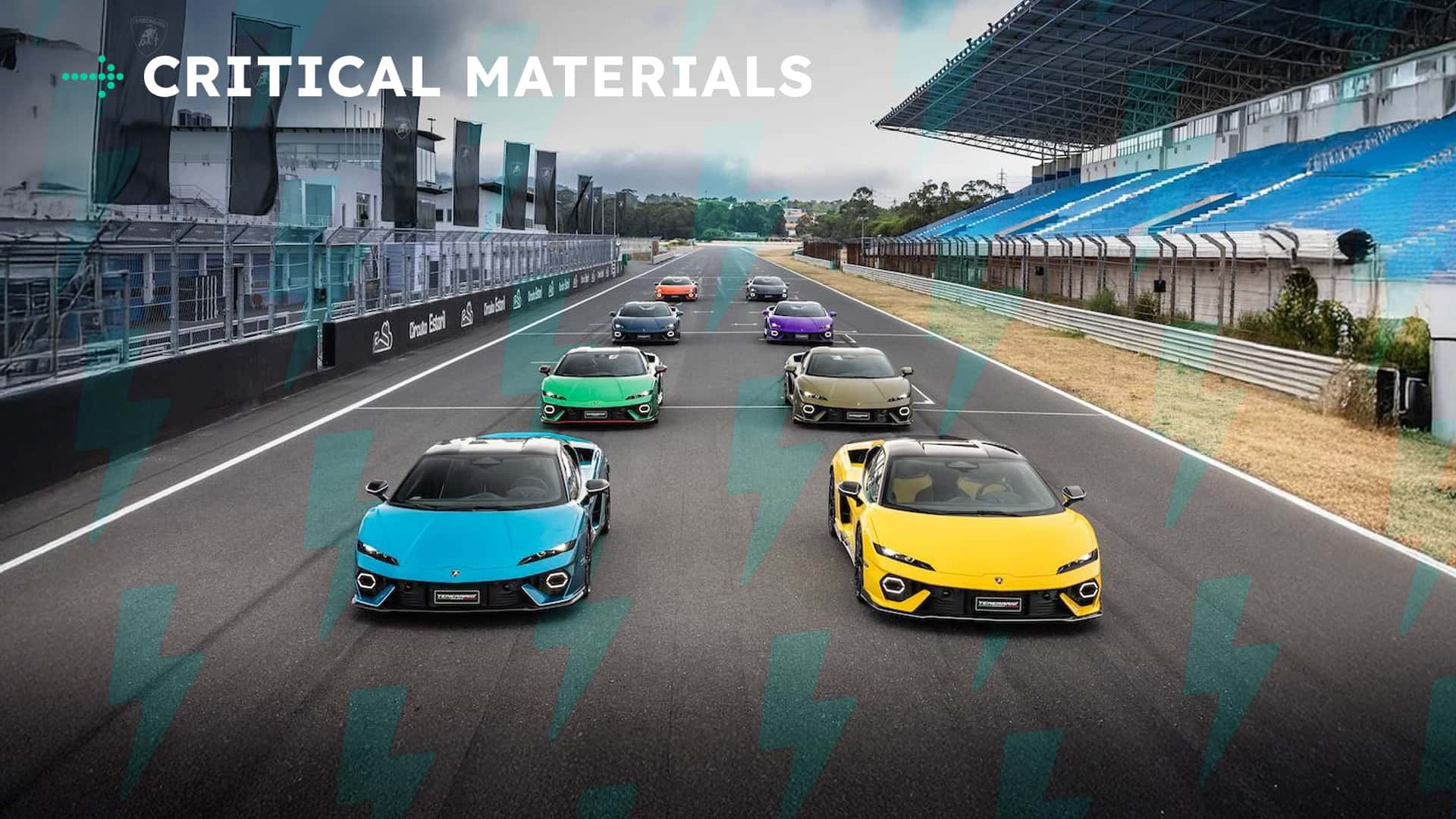
I can remember a few years ago when buying a hybrid meant that you were buying an economy car. I mean, for most of us, that's probably true—buying something that will sip fuel but still has a very capable tried-and-true combustion engine if needed. But for rich people with deep pockets? Hybrids can be fun.
That's why Lamborghini went all-out on them, after all. And now, its boss confirms: hybrids were the right move at exactly the right time.
Welcome back to Critical Materials, your daily roundup for all things electric and tech in the automotive space. Also on deck: the lithium industry's gold rush moment is over and Tesla's Robotaxi pricing is growing up as it plans to expand. Let's jump in.
30%: Lamborghini Boss Says Going All-In On Hybrids Was The 'Right' Choice

If you ever needed proof that Lamborghini's hybrid supercars still slap just as hard as an old-school Diablo, the brand just delivered it in the form of its annual earnings report.
The Italian automaker managed to deliver 5,681 cars during the first half of 2025. That might not seem like a lot compared to, say, Tesla or Toyota. But for Lamborghini? That 2% year-over-year increase is record-breaking (literally) and works out to the brand earning just over $285,000 in revenue—per car sold.
Stephan Winkelmann, the brand's CEO, attributes the interest in the brand to its decision to hybridize its entire lineup. That means no matter what you're buying—whether it be the V12-powered Revuelto, twin-turbo Temerario V8, or Urus SE SUV—it's all electrified in some way.
“The results from the first six months of 2025 are solid despite global economic and political instability, confirming that the decision to hybridize the entire range was the right one,” said Winkelmann.
"The success of the Revuelto and Urus SE demonstrates that our vision is shared by our customers, and we now look forward to the market launch of the Temerario, which will complete the first fully hybrid range in the segment."
The point that Winkelmann is getting across is that this is no longer the Prius-era of hybridization. Just because a car has a battery doesn't make it soft. If anything, it adds an extra electric kick to the mix thanks to the torque supplied by electric motors. You can still enjoy the banshee scream of a V12 and get a few more miles per gallon (although, let's be honest, fuel economy isn't why you're buying a Lambo).
It's also important to note that keeping a gas engine in its cars wasn't some snap decision. Lamborghini has been echoing the same mantra for years, even noting in 2023 that it wasn't "the right time" for an all-electric supercar.
The brand did, however, recently push back its Lanzador EV until 2029. This isn't unexpected, especially as many brands (even those at the forefront of electrification) are pulling back in an uncertain EV climate. It's not that cut-and-dry, though, because new reports suggest that the Lanzador might just end up being a plug-in hybrid instead of a battery-electric powerplant as originally teased.
“We have to decide whether we go one way or the other very soon," said Winkelmann.
60%: Lithium Prices Are Crashing

Lithium mining was almost seen as the next gold rush. Just a few years ago, the entire auto industry was hellbent on moving to EVs as quickly as possible. The biggest bottleneck? Batteries, of course, and the raw materials that make them up.
There's just one problem: the modern white gold rush resulted in rapid oversupply as the global EV climate unexpectedly shifted.
The world can point its fingers at America here; it's okay. While the U.S. isn't the only country to blame, it's one of the largest automotive markets on the planet, which is why a complete retraction of federal support for EVs meant a nosedive in supply needs from automakers who were scraping every red cent they could find to allocate to batteries before the federal tax credit fell under attack.
Bloomberg gives insight into the current lithium crisis unfolding:
The global lithium market has been in turmoil for years, and now slower-than-expected growth in EV demand has been compounded by US President Donald Trump pulling in regulatory backing. Prices of the battery metal hit a record in 2022 but have since collapsed by nearly 90% amid a deep supply glut.
[Australian battery minerals provider Liontown] said Tuesday that “a portion” of its supplies to Ford were redirected to a Chinese buyer, in a sign of how challenges in the US are rippling through the supply chain. The American carmaker’s EV sales plunged in the second quarter, and the firm is overhauling its strategy.“The reality is the EV landscape has changed materially over the last few years, and we saw an opportunity for us to place these tons on behalf of Ford with another customer who wanted the product,” Liontown’s Chief Commercial Officer Grant Donald told investors Tuesday.
By rerouting some of the lithium originally planned for Ford, Liontown has effectively taken a chunk of minerals that make up EV batteries out of the U.S. supply chain and instead routed it to one of the more than 100 EV makers in China. That's not necessarily a bad thing—a company needs to do what it has to do to stay afloat, especially in a margin-starved industry like lithium. However, it should act like a looking glass to see where the market is refocusing as it loses American support.
Lithium prices are tumbling. In fact, they're now down almost 90% since peaking in 2022 when automakers were going full steam ahead on BEVs. But now,
Jakob Stausholm, the CEO of a global mining firm Rio Tinto, says that lithium prices are "clearly unsustainable." In fact, the group notes that current pricing for the lithium has fallen below the incentive level needed for new processing and production equipment online.
The good news is that this isn't projected to be forever. Experts say this is just the market working to correct itself from its insane high in 2022. First, it needs to hit the floor, then rebound to what the market really sees as fair. But with geopolitical turmoil fueling the EV uncertainty around the world, that floor could be a lot lower than originally anticipated.
"The lithium market is demonstrating classic boom-bust dynamics. Prices surged to unsustainable highs, triggering massive supply responses that have now overshot more moderate demand growth," said Sarah Chen, an economist who focuses on the mining industry. "We're in the painful adjustment phase that will eventually lead to a more balanced market."
90%: Tesla Kills $6.90 Meme Price For Robotaxi As It Prepares To Expand

Every time I picture Elon Musk setting the price for something, I'd imagine his office sounds like some sort of Beavis and Butt-Head bit. Take the Robotaxi, for example, which launched with a $4.20 go-anywhere price tag and quickly became a more expensive $6.90.
And if you can't see the intended joke there, I'm not sure you and Musk can be friends.
Tesla and Waymo have been going tit-for-tat recently with their service offerings in Austin. For example, when Tesla decided to expand its service area into a giant, erm...joke, Waymo responded by expanding its service offering to 90 square miles. And when Tesla decided to expand outside of Austin, Waymo announced it has its sights set on Dallas.
Now Tesla has responded by taking its gloves off and flipping on dynamic pricing as it officially expands its offering to California and prepares for further moves.
One user on X posted that he was able to take a trip from tip-to-tip in Tesla's Robotaxi service area and rack up a bill as much as $13.71. Comparatively, Uber—which is the way to order up a Waymo in Austin—quoted $16.70 for the same ride. I checked the same ride at the time of writing and was quoted $18.95 for UberX, $16.18 for Uber Share, and $21.60 for Uber Comfort Electric.
Admittedly, it's cheaper. That has always been Tesla's selling point of the Robotaxi service—that it's cheaper than a human driver. In this particular example, Tesla's service is around 22% cheaper than Uber. Musk's pricing logic suggests that this could continue to drop as the Robotaxi network scales across the U.S., potentially reaching an operating cost per mile of between $0.25 and $0.40.
Now comes the hard part: actually solving self-driving (and scaling).
Tesla is kind of putting the cart before the horse here as it scales its operations before actually solving that tricky autonomy problem. This means deploying its cars with so-called safety monitors despite originally claiming nobody would be in the front seat. Now, as it officially launches in California, the automaker must deploy the cars with a safety driver as required by the California Public Utilities Commission, especially since it somehow doesn't hold a permit in the state for operating autonomous vehicles.
That kind of removes the whole "robo" part from "taxi," but knowing Tesla this will likely be a temporary move until it is issued the proper permitting—and also solves that whole self-driving thing.
San Francisco is just one of the many areas where Tesla says it's currently seeking regulatory permission to launch its paid (somewhat) autonomous ride-hailing service. The automaker claims that it will then use those same geofenced areas to launch its unsupervised Full Self-Driving feature starting towards the end of 2025.
100%: How Are We Feeling About Robotaxis?

Call them autonomous vehicles, robotaxis, driverless menaces—whatever you prefer. I like to get everyone's temperature about this one now and again. A recent survey of about 8,000 people gauged the perception of how folks are feeling about AVs in mid-2025. As it turns out, nearly half of the respondents say that they'd never even consider riding in one.
I'll admit that I'm kind of surprised by this response. More than 3,500 people say that they'd never even consider taking a short ride in an AV shows a lot of distrust in the self-driving industry.
Do you share that same sentiment? Why do you think people are really hesitant to trust a car without a driver? Let me know your thoughts in the comments.







